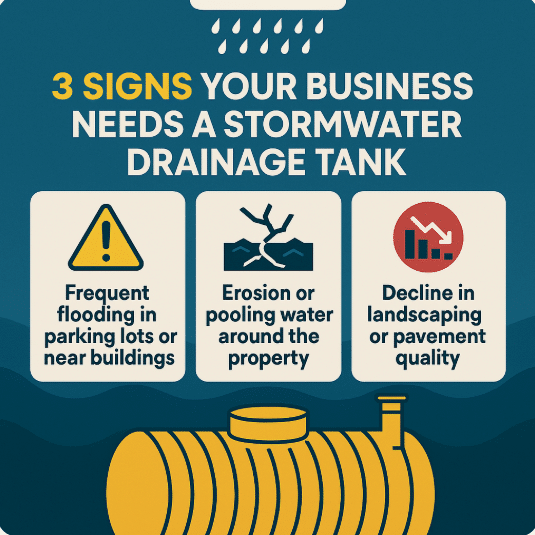
1. You Experience Frequent Flooding or Pooling Water
If your parking lot, loading docks, or low-lying areas regularly collect water after a storm, you’re likely dealing with inadequate drainage infrastructure. Even a few inches of standing water can damage foundations, asphalt, and landscaping—not to mention create safety hazards for employees and customers.
2. You’re Located in a Hurricane or High-Rainfall Zone
Businesses in Gulf Coast states, the Southeast, and other hurricane-prone areas are at increased risk of stormwater overflow. Local building codes are becoming stricter, and insurance carriers are growing less tolerant of repeat claims tied to water damage. Installing a sump or stormwater tank not only mitigates these risks but may also lead to lower premiums. In fact, many insurance providers—particularly those aligned with the National Flood Insurance Program (NFIP)—offer premium discounts and financial incentives for properties that invest in flood risk mitigation measures, including engineered stormwater drainage tanks.
3. You’re Expanding or Remodeling Your Property
Adding square footage often increases impervious surfaces—like concrete or rooftops—which reduce natural water absorption. Stormwater tanks help offset this change and can support your compliance with local stormwater retention ordinances. Additionally, incorporating flood-resistant infrastructure during remodeling can qualify your property for private insurance benefits and NFIP incentives.
Smart Prevention Is Smart Business
Stormwater drainage tanks aren’t just a backup—they’re a proactive investment in protecting your physical assets and operational uptime. KBK offers custom-engineered tanks in various sizes to meet your drainage and retention needs.
Today’s insurance climate increasingly rewards businesses that take mitigation seriously. From sump tanks and floodproofing materials to elevation of critical infrastructure, there’s no shortage of actions you can take to improve resilience and lower your risk profile.
Contact us to discuss sizing, placement, or bundling your tank into a broader flood resilience strategy.
